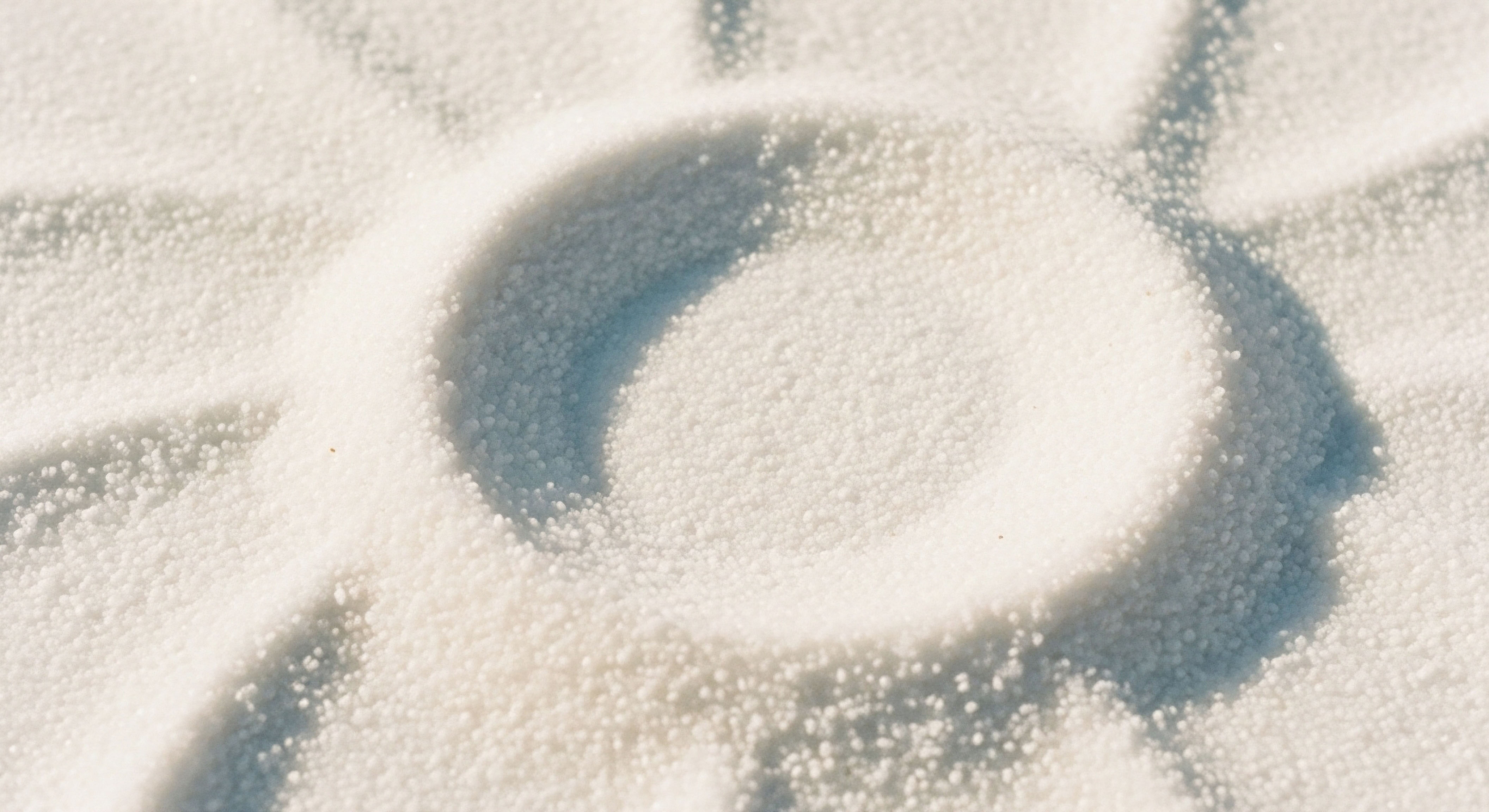

Fundamentals
The decision to step away from a structured hormonal protocol represents a profound desire to reclaim your body’s innate capacity for self-regulation. You have experienced the stability that optimized testosterone provides, and now you are asking a critical question ∞ Can the architecture of your daily life ∞ your nutrition, your movement, your sleep, and your stress resilience ∞ be robust enough to sustain that feeling of vitality on its own?
This inquiry moves us into the heart of personal biology, exploring the very systems that govern your energy, mood, and function. The journey off therapeutic testosterone is a process of biological reawakening, a deliberate effort to restart a complex internal conversation that has been quieted.
At the center of this conversation is a sophisticated feedback system known as the Hypothalamic-Pituitary-Gonadal (HPG) axis. Think of it as the body’s internal thermostat for testosterone production. The hypothalamus, in the brain, senses when testosterone levels are low and releases Gonadotropin-Releasing Hormone (GnRH).
This signal travels to the pituitary gland, prompting it to release Luteinizing Hormone (LH) and Follicle-Stimulating Hormone (FSH). LH then travels through the bloodstream to the testes, delivering the direct command to produce testosterone. When testosterone levels rise to an optimal point, this same system signals the hypothalamus and pituitary to slow down, perfectly modulating production.
When you introduce testosterone from an external source during therapy, the body senses that levels are sufficient. Consequently, the hypothalamus quiets its GnRH signal, the pituitary reduces its LH output, and the entire production line goes dormant. Discontinuing therapy means this system must be prompted to restart, a process that is neither instantaneous nor guaranteed to return to its previous state without support.
The transition off hormonal therapy is a biological recalibration, aiming to restart the body’s own testosterone production system through targeted lifestyle inputs.

The Four Pillars of Endocrine Support
Your lifestyle choices are the primary inputs your body uses to gauge whether it is in an environment that is safe and resourced enough to support robust hormonal function. Each pillar sends a distinct set of signals to the HPG axis, influencing its ability to recover and self-stabilize. A combination of resistance training and cardiovascular exercise is effective for maintaining a healthy body composition and will help maximize the body’s natural testosterone production.
- Nourishment Architecture This involves providing the raw materials for hormone synthesis. Your body cannot construct testosterone from nothing. It requires specific micronutrients, such as zinc and vitamin D, and a balance of macronutrients ∞ proteins, healthy fats, and complex carbohydrates ∞ to fuel the entire endocrine system. A diet rich in whole foods is the foundation of this architecture.
- Movement and Muscular Signaling Physical activity, particularly resistance training, is a potent stimulus for testosterone production. The physical stress of lifting weights signals to the body a need for strength and repair, which in turn prompts an acute hormonal response. This type of exercise directly communicates a demand for anabolic processes, encouraging the HPG axis to come back online.
- Sleep and Endocrine Repair The majority of your daily testosterone production occurs during sleep. Deep, restorative sleep is when the pituitary gland is most active in releasing its signaling hormones. Chronic sleep deprivation directly disrupts this cycle, elevating stress hormones like cortisol, which can further suppress the HPG axis and blunt recovery. Prioritizing seven or more hours of quality sleep per night is a non-negotiable aspect of hormonal maintenance.
- Stress Modulation and Cortisol Control The body’s central stress response system is intrinsically linked with the HPG axis. Chronic stress leads to persistently elevated levels of cortisol, a catabolic hormone. Cortisol and testosterone have a reciprocal relationship; when one is high, the other tends to be low. High cortisol levels send a powerful inhibitory signal to the hypothalamus, effectively telling it that the body is in a state of crisis and that functions like reproduction and building muscle are a low priority. Managing stress through practices like meditation or breathwork helps to lower this inhibitory signal, creating a more favorable environment for testosterone production.

What Are the Initial Effects of Stopping TRT?
When therapeutic testosterone is withdrawn, the body experiences a gap between the cessation of the external supply and the restart of its own production. This period, which can last for weeks or even months, is often characterized by the return of low testosterone symptoms.
Individuals frequently report significant fatigue, a decline in mood and cognitive function, reduced libido, and a loss of muscle mass. These experiences are a direct result of the HPG axis slowly and tentatively beginning its function again. Lifestyle interventions are critical during this phase.
They may not be sufficient on their own to immediately restore optimal levels, but they provide essential support to mitigate the severity of these symptoms and create the best possible conditions for the HPG axis to recover.
The table below outlines how each lifestyle pillar directly supports the body’s hormonal systems during this critical transition period.
| Lifestyle Pillar | Primary Biological Mechanism | Direct Effect on HPG Axis |
|---|---|---|
| Strategic Nutrition | Provides essential precursors and cofactors for steroidogenesis (hormone production). | Supports testicular function by ensuring availability of key nutrients like zinc and vitamin D. |
| Resistance Training | Creates an acute demand for anabolic hormones to repair and build muscle tissue. | Stimulates the pituitary to release LH, directly signaling the testes to produce testosterone. |
| Adequate Sleep | Facilitates the primary daily pulse of LH and testosterone release. | Allows for optimal pituitary function and reduces the catabolic influence of cortisol. |
| Stress Management | Lowers circulating levels of cortisol, a primary inhibitor of GnRH release. | Removes a key brake on the hypothalamus, allowing the HPG axis to function more effectively. |


Intermediate
For the individual who understands the fundamentals of the HPG axis, the central question evolves from “if” lifestyle can help to “how” it can be integrated into a structured, effective protocol for discontinuing therapy.
The reality is that for many, especially those who have been on a hormonal optimization protocol for an extended period, lifestyle changes alone create a supportive environment but may be insufficient to fully restart endogenous production in a timely manner.
The degree of HPG axis suppression is a significant variable; the longer the brain’s signaling has been dormant, the more challenging it can be to reawaken. This is where a medically supervised transition, often called Post-Cycle Therapy (PCT), becomes a critical component of the strategy. This approach uses specific pharmaceutical agents to directly stimulate the HPG axis at different points, bridging the gap while lifestyle modifications solidify long-term stability.

The Spectrum of HPG Axis Recovery
The time course for HPG axis recovery is highly variable, ranging from a few weeks to several months, and in some cases, full recovery may take up to two years or may not occur at all. Factors influencing this timeline include the duration of therapy, the specific compounds used, the dosage, and the individual’s age and baseline hormonal health before starting the protocol.
Abruptly stopping therapy without a plan ∞ a “cold turkey” approach ∞ creates the most severe withdrawal experience, as the body is left with neither an external nor an internal supply of testosterone. A carefully planned tapering of the dosage can help, but for a more robust and predictable recovery, a formal PCT protocol is often recommended. This protocol is designed to actively kickstart the body’s natural production machinery.
A medically supervised protocol uses specific agents to directly stimulate the HPG axis, serving as a bridge to allow lifestyle changes to establish long-term hormonal balance.

Designing a Post-TRT Recovery Protocol
A comprehensive recovery plan integrates targeted medical interventions with the foundational lifestyle pillars. The goal of the medical side is to directly command the pituitary and testes to resume their functions, while the lifestyle side ensures these organs have everything they need to respond to those commands. This dual approach offers the highest probability of a successful transition.

Key Therapeutic Agents in a Recovery Protocol
The medications used in a post-TRT protocol are not about replacing testosterone; they are about restarting the machinery that produces it. These agents are typically used for a defined period, such as 4-8 weeks, immediately following the cessation of testosterone therapy.
- Gonadorelin This peptide is a synthetic version of GnRH. Its function is to directly stimulate the pituitary gland, mimicking the very first step in the HPG axis. By administering Gonadorelin, typically via subcutaneous injection, you are sending a powerful signal to the pituitary to release LH and FSH, effectively bypassing a potentially sluggish hypothalamus. This is often used during the final weeks of TRT and the initial weeks of PCT to “prime the pump.”
- Clomiphene Citrate (Clomid) This is a Selective Estrogen Receptor Modulator (SERM). It works at the level of the hypothalamus and pituitary gland. Estrogen, even in men, provides negative feedback to the HPG axis. Clomiphene blocks the estrogen receptors in the brain, tricking the system into thinking estrogen levels are low. In response, the hypothalamus and pituitary increase their output of GnRH and LH/FSH to compensate. This sustained stimulation encourages the testes to ramp up their own testosterone production. Studies have shown clomiphene to be an effective therapy for improving testosterone levels in men with hypogonadism.
- Tamoxifen (Nolvadex) Another SERM that works in a similar fashion to Clomiphene, blocking estrogenic feedback at the pituitary to increase LH and FSH output. It is often used in conjunction with or as an alternative to Clomiphene in PCT protocols.
- Anastrozole This is an Aromatase Inhibitor (AI). As the testes begin producing testosterone again, some of it will naturally convert to estrogen via the aromatase enzyme. In some individuals, this estrogen level can rise too quickly, which can cause side effects and increase the negative feedback on the HPG axis. Anastrozole works by blocking the aromatase enzyme, thereby controlling estrogen levels and keeping the inhibitory signal low while the system recalibrates.
The following table compares a transition strategy relying solely on lifestyle with one that incorporates a medically assisted protocol.
| Aspect of Recovery | Lifestyle-Only Approach | Medically Assisted Protocol (PCT) |
|---|---|---|
| HPG Axis Stimulation | Indirect. Relies on signals from exercise and nutritional status to slowly encourage recovery. | Direct and robust. Uses agents like Clomiphene and Gonadorelin to command the pituitary to release LH/FSH. |
| Speed of Recovery | Highly variable and often slow, potentially taking many months to see significant improvement. | Accelerated. Aims to restore natural production within a structured 4-8 week timeframe. |
| Symptom Management | Symptoms of low testosterone (fatigue, brain fog, low libido) are common and can be prolonged. | Minimizes the duration and severity of the “crash” by bridging the hormonal gap more quickly. |
| Predictability | Low. Success is heavily dependent on individual genetics, age, and previous therapy duration. | Higher. While not 100% guaranteed, it provides a more reliable pathway for HPG axis restart. |
| Primary Role | To create the optimal long-term physiological environment for hormonal health. | To overcome the initial state of deep HPG axis suppression and initiate recovery. |


Academic
An academic appraisal of whether lifestyle interventions alone can sustain eugonadal testosterone levels following the cessation of exogenous androgen therapy requires a mechanistic examination of the Hypothalamic-Pituitary-Gonadal (HPG) axis’s recovery potential. The core issue is overcoming the profound negative feedback inhibition induced by therapy.
While lifestyle factors such as diet, exercise, and sleep are indisputably important modulators of endocrine function, their ability to independently overcome a deeply suppressed HPG axis is physiologically constrained. The success of a transition is largely predicted by the pre-existing state of the axis, the duration and dosage of therapy, and the strategic use of pharmacological agents to restore endogenous pulsatile gonadotropin secretion.

Predictors of HPG Axis Recovery
The probability of the HPG axis returning to its baseline function is not uniform across all individuals. Clinical research, particularly data extrapolated from studies on androgenic anabolic steroid (AAS) users, provides significant insight. One prospective study demonstrated that after a three-month cessation period combined with Post-Cycle Therapy (PCT), approximately 79.5% of subjects achieved satisfactory recovery of HPG axis function, while 20.5% did not.
This highlights that a significant minority may face prolonged or incomplete recovery even with medical assistance. Several key factors correlate with poor recovery outcomes:
- Duration of Suppression A strong negative correlation exists between the length of time on therapy and the potential for testosterone level recovery. Prolonged exposure to exogenous androgens leads to more profound and potentially permanent alterations in hypothalamic GnRH pulse generator function and pituitary sensitivity.
- Dosage and Compound Load The total dose and the number of compounds used correlate negatively with recovery. Higher supraphysiological doses create a deeper state of suppression that is more difficult to reverse.
- Baseline Hypogonadism The initial reason for commencing therapy is a critical factor. An individual with primary hypogonadism (testicular failure) has no capacity to restart production. For those with secondary hypogonadism (pituitary or hypothalamic insufficiency), recovery depends on whether the underlying cause can be addressed. For many men who start TRT due to age-related decline, the axis is already functioning sub-optimally, making a full return to youthful levels via lifestyle alone improbable.

The Cellular and Hormonal Mechanics of Recovery
Recovery is a multi-stage process that begins at the hypothalamus. The first step is the re-establishment of pulsatile GnRH secretion. This can be significantly delayed. Pharmacological intervention with a SERM like Clomiphene Citrate is effective because it directly addresses the primary feedback mechanism. By blocking estrogen receptors at the hypothalamus, it creates a perceived state of hormonal deficiency, which acts as a powerful stimulus for GnRH release. This in turn drives the pituitary to secrete LH and FSH.
The response of the testes themselves is the next critical step. The Leydig cells must regain their sensitivity to LH to produce testosterone. Sertoli cell function, essential for spermatogenesis, must also recover. The level of Inhibin B, a hormone produced by Sertoli cells, can serve as a valuable marker for the restoration of the spermatogenic epithelium and overall testicular health.
A correlation between Inhibin B and total testosterone levels has been identified, suggesting that healthy Sertoli cell function is linked to the overall recovery of the gonads.
Successful HPG axis recovery is a complex process where lifestyle factors modulate an environment made favorable by targeted pharmacological interventions that overcome deep endocrine suppression.

Can Lifestyle Inputs Overcome Deep Suppression?
From a biochemical perspective, lifestyle interventions act as system modulators rather than primary drivers in the context of post-TRT recovery. For example, resistance exercise can transiently increase LH pulse amplitude, and adequate sleep is necessary for the nocturnal testosterone surge. However, these signals may be insufficient to restart a system that has been silenced for years.
The GnRH pulse generator may have become desensitized, or pituitary gonadotroph cells may have down-regulated their receptors. In such a state of deep suppression, the endogenous signals from lifestyle changes may not reach the threshold required to trigger a response.
This is where the distinction between “support” and “sufficiency” becomes critical. Lifestyle factors are sufficient for maintaining hormonal balance within a functioning system. After TRT, the system is often non-functioning. The role of a PCT protocol is to force the system back into a functional state.
Once it is operational again, the lifestyle pillars become the primary tools for long-term, sustainable maintenance. Without the initial pharmacological push, many individuals would remain in a state of prolonged hypogonadism, where the negative physiological and psychological symptoms would make adherence to any rigorous lifestyle plan exceptionally difficult.

What Is the Role of Neuroendocrine Withdrawal Symptoms?
The transition period is also complicated by a distinct AAS withdrawal syndrome. The hypogonadal state that follows cessation is associated with significant psychological symptoms, including dysphoria, fatigue, and in some cases, major depression. These symptoms are not merely subjective feelings; they are the neurochemical manifestation of an abrupt deprivation of androgens in the central nervous system.
This state can severely compromise an individual’s motivation and ability to adhere to the very lifestyle changes ∞ intense exercise, disciplined nutrition, and stress management ∞ that are required for their recovery. This creates a challenging feedback loop where the symptoms of withdrawal impede the behaviors that could alleviate them. A well-structured PCT protocol that shortens this hypogonadal window is therefore also a strategy for improving psychological well-being and adherence during the transition.

References
- Lykhonosov, M. P. et al. “Peculiarity of recovery of the hypothalamic-pituitary-gonadal (hpg) axis, in men after using androgenic anabolic steroids.” Problems of Endocrinology, vol. 66, no. 4, 2020, pp. 59-67.
- Kanayama, Gen, et al. “Treatment of Anabolic ∞ Androgenic Steroid Dependence ∞ Emerging Evidence and Its Implications.” Drug and Alcohol Dependence, vol. 109, no. 1-3, 2010, pp. 6-13.
- de Ronde, Willem, and Eric J. G. M. de Boer. “Clomiphene citrate for men with hypogonadism ∞ a systematic review and meta-analysis.” Andrology, vol. 10, no. 1, 2022, pp. 5-15.
- Dáttilo, M. et al. “Effects of Sleep Deprivation on Acute Skeletal Muscle Recovery after Exercise.” Medicine and Science in Sports and Exercise, vol. 52, no. 2, 2020, pp. 507-514.
- Leproult, Rachel, and Eve Van Cauter. “Effect of 1 Week of Sleep Restriction on Testosterone Levels in Young Healthy Men.” JAMA, vol. 305, no. 21, 2011, pp. 2173-2174.
- Shabsigh, Ridwan, et al. “Clomiphene citrate for the treatment of testosterone deficiency.” BJU International, vol. 96, no. 6, 2005, pp. 889-892.
- Wheeler, K. M. et al. “A randomized, double-blind, placebo-controlled study of clomiphene citrate on the hypothalamic-pituitary-gonadal axis in men with idiopathic male infertility.” Fertility and Sterility, vol. 55, no. 2, 1991, pp. 345-350.
- Miyagawa, Yasushi, et al. “Clomiphene Citrate Treatment as an Alternative Therapeutic Approach for Male Hypogonadism ∞ Mechanisms and Clinical Implications.” International Journal of Molecular Sciences, vol. 24, no. 13, 2023, p. 10637.
- Taylor, F. and P. Levine. “Clomiphene citrate and its effects upon pituitary-gonadal function in the human.” The Journal of Clinical Endocrinology & Metabolism, vol. 25, 1965, pp. 583-591.
- Moskovic, Daniel J. et al. “Clomiphene citrate is safe and effective for long-term management of hypogonadism.” BJU International, vol. 110, no. 10, 2012, pp. 1524-1528.

Reflection

Recalibrating Your Internal Systems
You began this inquiry seeking to understand if your daily actions could replace a clinical protocol. You have seen that the human body is a system of profound complexity, where lifestyle and medicine can work in concert.
The knowledge you have gained about your own internal feedback loops, the HPG axis, and the delicate interplay of hormones is the true foundation of sustainable wellness. The journey off a therapy is a path of reconnecting with your body’s own signals. It requires listening intently to its responses, providing it with the foundational support it needs through your lifestyle, and understanding when a targeted intervention can help restore its innate function.
Consider the architecture of your own life. Which of the pillars ∞ nourishment, movement, sleep, or stress resilience ∞ presents the greatest opportunity for reinforcement? Understanding the science is the first step. Applying it, consistently and with intention, is how you translate that knowledge into a lived reality of vitality and function.
Your personal biology is unique, and this new understanding empowers you to engage with your health not as a passive recipient of treatment, but as an active participant in your own continued well-being.

Glossary

testosterone production

testosterone levels

pituitary gland

hpg axis

lifestyle changes

post-cycle therapy

hpg axis recovery

gonadorelin

clomiphene citrate

aromatase inhibitor

secondary hypogonadism




